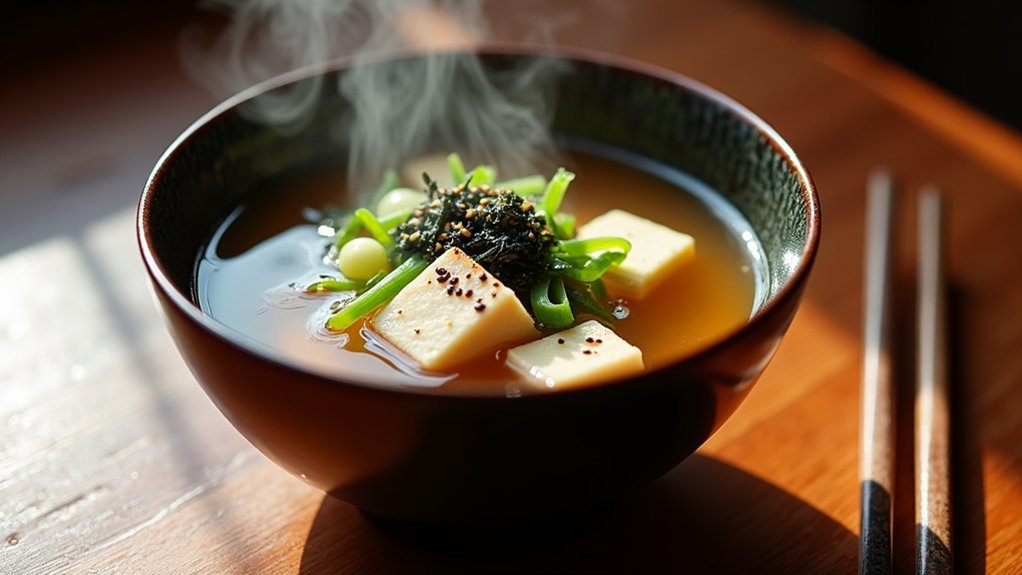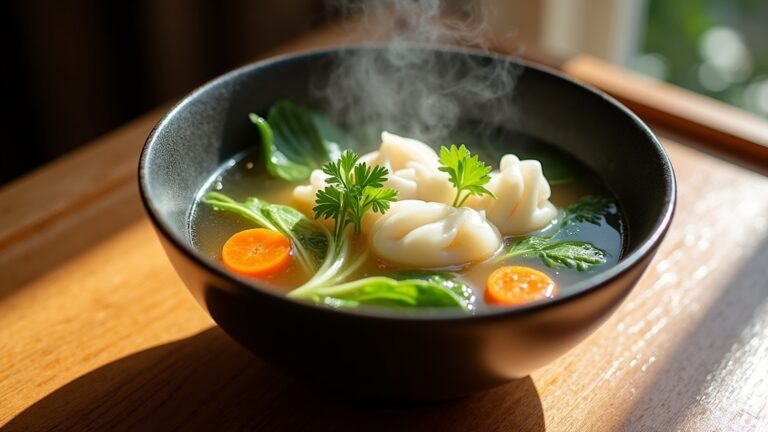Miso Soup Recipe
Miso soup is one of my favorite comforting dishes to prepare. It starts with dashi, a savory broth, and then I mix in miso paste for that umami kick. I love adding soft tofu, wakame seaweed, and fresh green onions for extra flavor and texture. It’s quick and easy to customize with seasonal veggies, too. Trust me, once you try it, you’ll appreciate its nourishing warmth—and there’s so much more to discover about this classic dish!
Contents
History
When I think about the history of miso soup, I can’t help but marvel at its deep roots in Japanese culture. Originating over a thousand years ago, miso soup embodies the harmony between simplicity and depth. It’s fascinating to reflect on how this humble dish reflects the ancient origins of fermentation practices in Japan, transforming soybeans into a savory, nutritious base. Miso soup isn’t just a meal; it holds immense cultural significance, symbolizing nourishment and comfort throughout generations. Each bowl whispers stories of family gatherings and shared moments, connecting the past with the present. As I explore its evolution, I’m inspired by how this timeless dish continues to innovate, adapting to modern tastes while honoring its rich heritage.
Recipe
Miso soup is a traditional Japanese dish that is both comforting and nourishing. It is made with a base of dashi, a savory broth that can be crafted from kombu (dried seaweed) and bonito flakes (dried fish flakes). The key ingredient, miso paste, is fermented soybean paste that adds depth and umami flavor to the soup. Miso soup can be enjoyed on its own or as a side to a larger meal, making it a versatile addition to any dining experience.
This soup is not only quick and easy to prepare, but it also allows for a variety of ingredient combinations, such as tofu, seaweed, and green onions. By customizing the ingredients, you can create a miso soup that caters to your taste preferences and dietary needs. Whether you are looking for a light appetizer or a soothing dish to warm you up on a cold day, this recipe is sure to deliver delicious results.
Ingredients:
- 4 cups dashi (Japanese soup stock)
- 3 tablespoons miso paste (white or red)
- 1 cup soft tofu, cubed
- 1/2 cup green onions, sliced
- 1/4 cup wakame seaweed (dried)
- Soy sauce (optional, for seasoning)
Instructions:
In a medium saucepan, bring the dashi to a gentle simmer over medium heat. Once simmering, add the cubed tofu and wakame seaweed, allowing them to warm through for about 2-3 minutes. In a small bowl, mix the miso paste with a ladle of the hot broth until it’s smooth, then stir it back into the pot, ensuring it’s well combined. Cook for an additional 2 minutes, being careful not to boil, as boiling can diminish the flavor of the miso. Finally, remove from heat and sprinkle the sliced green onions on top before serving.
Extra Tips:
When making miso soup, it is important to choose the right type of miso paste. White miso is milder and sweeter, while red miso has a stronger flavor. Adjust the amount of miso paste according to your taste preference. Additionally, you can enhance the soup by adding other ingredients such as mushrooms, bok choy, or even a splash of sesame oil for added richness. Remember to serve the soup warm, as miso soup is best enjoyed fresh.
Cooking Steps
Now that we’ve gathered our ingredients, it’s time to bring this comforting miso soup to life. I’ll guide you through each step, from mixing the dashi with miso to adding fresh vegetables and tofu. Let’s get started on creating a warm bowl of deliciousness!
Step 1. Gather Miso and Dashi
To create a flavorful miso soup, I always start by gathering the essential ingredients: miso paste and dashi. Choosing the right miso varieties can elevate your soup’s flavor profile—think about using white miso for a lighter taste or red miso for a bolder, richer experience.
Next, I focus on dashi types, which form the soup’s umami base. You can opt for traditional kombu and bonito flakes for a classic taste or explore instant dashi for convenience without sacrificing flavor.
Here’s what I gather:
- Miso Paste – Select your preferred variety.
- Dashi Stock – Choose your type, whether homemade or instant.
- Water – The perfect base for infusing flavors.
With these ingredients, I’m ready to craft my miso soup masterpiece!
Step 2. Add Tofu and Seaweed
As the dashi simmers, I gently cube the tofu and prepare to add it to the pot, knowing it will soak up the rich flavors of the broth. Tofu not only adds a delightful texture but also brings numerous health benefits, such as being a great source of protein and essential amino acids. I carefully toss in the tofu, letting it warm through. Next, I select a variety of seaweed—usually wakame for its tender texture and subtle umami. As I sprinkle it into the pot, I can already imagine how it’ll enhance the soup’s depth. Both ingredients harmonize beautifully, creating a nourishing blend that elevates the miso soup to a whole new level of deliciousness.
Step 3. Simmer With Vegetables Added
Once the tofu and seaweed have warmed through, I turn my attention to the colorful array of vegetables waiting to join the pot. Each addition brings its own unique flavor combinations and vegetable benefits that elevate the soup to a new level. I gently add:
- Carrots – Their sweetness balances the umami of the miso.
- Spinach – A vibrant green that adds a nutritional punch.
- Mushrooms – Earthy and rich, they deepen the soup’s complexity.
As the vegetables simmer, I can already smell the delightful mingling of flavors. This step is essential, allowing the veggies to soften and infuse the broth with their nutrients. It’s a vibrant, nourishing medley that transforms my miso soup into a comforting, healthful dish!
Step 4. Incorporate Green Onions
While the vegetables continue to simmer, I grab a handful of fresh green onions, their bright green tops adding a pop of color and a sharp, zesty note to the soup. I love using multiple green onion varieties, like the classic scallions and the more robust bunching onions, to deepen the flavor profile. As I slice them thinly, I can’t help but think about the green onion benefits—rich in vitamins A and C, they also boast anti-inflammatory properties. Once the vegetables are tender, I sprinkle the sliced green onions into the pot, letting them soften just a bit in the hot broth. This simple addition transforms the soup, bringing a fresh, vibrant essence that elevates every spoonful.
Step 5. Adjust Seasoning to Taste
With the green onions adding their vibrant touch, it’s time to focus on the flavor. Adjusting the seasoning is essential for achieving that perfect flavor balance. Here’s how I do it, tailored to my personal preference:
- Miso Paste: Start by adding a bit more miso if you crave deeper umami notes. Just a teaspoon can transform the broth.
- Soy Sauce: A splash of soy sauce can enhance the savory aspect; remember, it’s all about moderation to avoid overpowering the miso.
- Salt: If you find it lacking, a pinch of salt can elevate the flavors, but taste as you go to prevent oversalting.
Don’t hesitate to experiment—this soup is a canvas for your creativity! Adjust until it feels just right.
Nutritional Guide
As I plunge into the world of miso soup, I can’t help but appreciate its impressive nutritional profile. Packed with essential nutrients, this dish not only warms the soul but also supports overall health. Rich in protein, fiber, and antioxidants, miso soup offers numerous nutrient benefits. Plus, it’s versatile enough to accommodate various dietary considerations, making it suitable for many lifestyles.
Here’s a quick glance at its nutritional highlights:
| Nutrient | Amount per Serving |
|---|---|
| Protein | 3 grams |
| Fiber | 1 gram |
| Sodium | 600 mg |
Incorporating miso soup into your meals can elevate your culinary experience while nourishing your body in delightful ways.
Final Thoughts
Embracing the art of making miso soup has been a delightful journey that blends tradition with creativity. Each bowl is a canvas, inviting me to explore diverse soup variations and add my personal touch. Here are three elements I love to incorporate for flavor enhancement:
Embracing miso soup is a creative journey, inviting endless variations and personal touches in every bowl.
- Fresh Ingredients: Using seasonal vegetables like bok choy or mushrooms elevates the soup’s freshness and vibrancy.
- Protein Boost: Adding tofu or edamame not only enriches the dish but also provides a satisfying texture.
- Umami Depth: Experimenting with dashi or seaweed can intensify that irresistible savory taste.
Ultimately, miso soup is more than a recipe; it’s an evolving experience. I encourage you to enjoy the process and let your creativity shine!
Frequently Asked Questions
Can I Use Instant Miso Paste for This Recipe?
Absolutely, I’ve used instant miso before! While it offers convenience, the flavor comparison to traditional miso might not be as rich. Still, it’s a great option for a quick, satisfying meal when I’m short on time.
How Long Does Miso Soup Last in the Fridge?
When it comes to miso soup shelf life, I’ve found it stays fresh for about three to five days in the fridge. Proper storage in an airtight container makes all the difference for delicious leftovers!
Is Miso Soup Vegan or Vegetarian-Friendly?
I love that miso soup can be both vegan and vegetarian-friendly! By choosing plant-based broth options and incorporating vegan ingredients like tofu and seaweed, you can create a delicious, innovative dish that everyone can enjoy.
What Are Common Variations of Miso Soup?
When I explore miso soup, I love experimenting with tofu variations, seaweed options, mushroom additions, and vibrant vegetable combinations. Each twist brings a unique flavor, making every bowl a delightful adventure for my taste buds!
Can I Freeze Miso Soup for Later Use?
I’ve found that freezing miso soup works well with proper techniques. Just store it in airtight containers, leaving space for expansion. This method preserves flavors and makes quick meals a breeze! Enjoy innovative miso storage!
Conclusion
As I ladle the warm, savory miso soup into a bowl, it feels like wrapping myself in a cozy blanket on a chilly day. This simple yet nourishing dish connects us to generations past, each sip brimming with tradition and comfort. I hope you find joy in crafting your own bowl of miso magic, letting its rich flavors soothe your spirit and warm your heart. So, gather your ingredients and let the culinary adventure begin!











